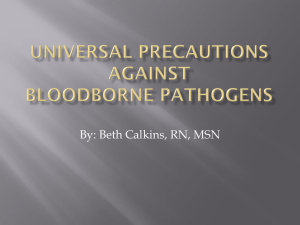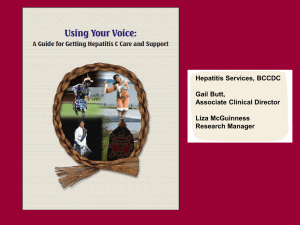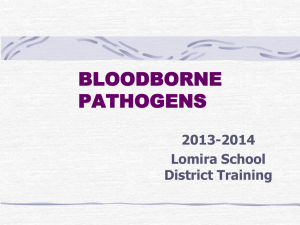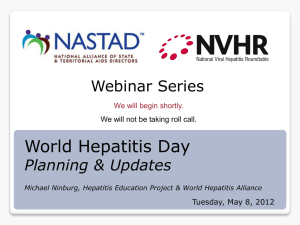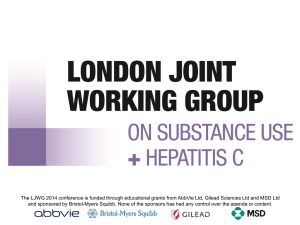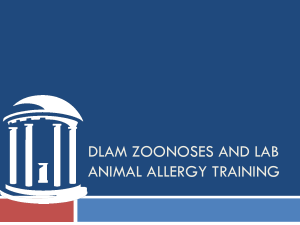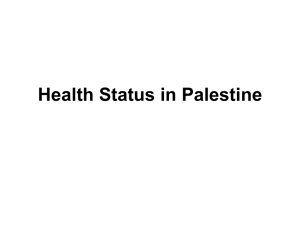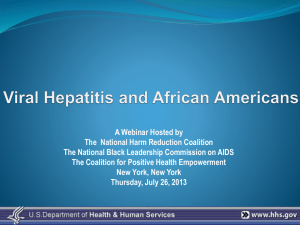An audit of hepatitis B, hepatitis C, HIV testing and uptake
advertisement
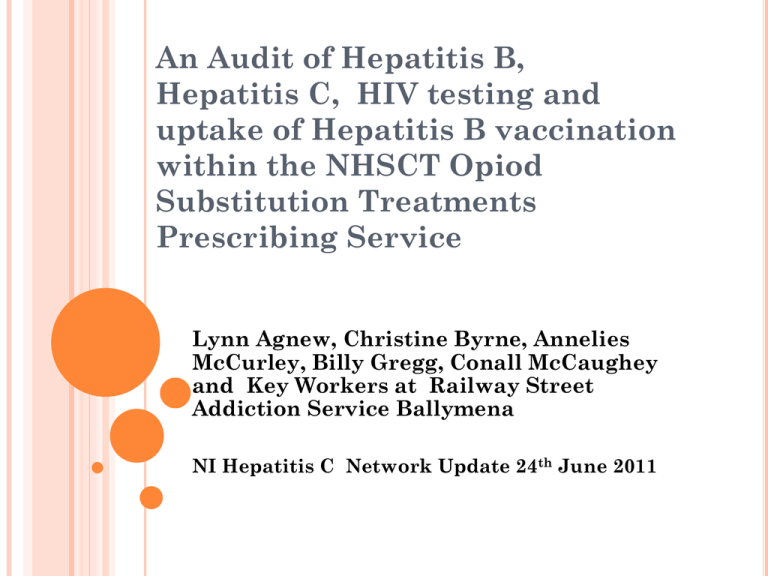
An Audit of Hepatitis B, Hepatitis C, HIV testing and uptake of Hepatitis B vaccination within the NHSCT Opiod Substitution Treatments Prescribing Service Lynn Agnew, Christine Byrne, Annelies McCurley, Billy Gregg, Conall McCaughey and Key Workers at Railway Street Addiction Service Ballymena NI Hepatitis C Network Update 24th June 2011 BACKGROUND Evidence vast majority of IVDUs offered testing for BBVs at least once:Data from Drug Misuse Database Unlinked anonymous testing screening Previous audits by NHSCT Evidence of retesting within last year not reassuring About 50% are unaware of their past or current Hepatitis C infection Hepatitis B vaccination histories often uncertain Estimated prevalence rates for Hepatitis C in current or former injecting drug users in NI (2009) 2009 Hepatitis C “Of the participating injecting drug users, 28%1 (26%, 40 of 153) had antibodies to hepatitis C.” “The majority, 92% (131 of 143), reported having ever had a voluntary confidential test for hepatitis C.” “Just over half (52%, 16 of 31) of the participating injecting drug users who had antibodies to hepatitis C were aware of their infection.” Source: Unlinked Anonymous Monitoring Survey of Injecting Drug Users Summary of the findings for 2009 from the two collaborating services in Northern Ireland: Health Protection Agency BACKGROUND NHSCT Addiction Services prescribe opiate substitute treatments (OST) primarily for heroin dependence but also for dependence on other opiods. Clients treated in secondary care and also primary care within a shared care scheme Currently no facilities for testing for BBVs in at Railway Street Clinic Ballymena. Testing for BBVs dependent on testing by primary care or if admitted to Addiction Unit Holywell Hospital BACKGROUND NHSCT Addiction Services prescribe opiate substitute treatments (OST) primarily for heroin dependence but also for dependence on other opiods. Clients treated in secondary care and also primary care within a shared care scheme Currently no facilities for testing for BBVs at Railway Street Clinic Ballymena. Testing for BBVs dependent on testing by primary care or if admitted to Addiction Unit Holywell Hospital Audit Standards Minimum standards for BBVs testing for those with risk factors 100% to be offered screening for Hepatitis B, Hepatitis C and HIV 100% to be offered screening tests at least yearly if ongoing risk factors 100% to be offered Hepatitis B vaccination 100% to achieve Anti-HBsAg titres > 100 mIU/ML METHOD Key Worker completed a BBV testing and Hepatitis B status summary with clients March –June 2011 Written consent obtained from client to access results of any previous BBV / Anti-HBs test results held by Primary Care or Regional Virus Laboratory Test results subsequently obtained from Regional Virus Laboratory Data on 150 of total caseload of 236 currently available Current data includes 126 with lifetime history of IV drug use SAMPLE DEMOGRAPHICS Lifetime history of IV drug use No history of IV drug use Missing data Male 87% (104) 9% (11) Female 71% (22) 29% (9) Mean age 11.6 years 11.5 years 18-25 years old 89% (16) 5.5% (1) 1 26+ years old 83% (110) 14 % (19) 3 Tested in Primary Care 88 % (61) 12% (7) 1 Tested in Secondary Care 87% (60) 10% (7) 3 Sample size 126 clients 20 clients Missing clients 4 clients TESTING FOR HEPATITIS B, HEPATITIS C AND HIV (TOTAL SAMPLE) Hep B Hep C HIV Ever tested 95% (143) 95% (143) 93% (140) Tested in last year 33% (49) 32% (48) 29% (44) Not tested in last year 34% (51) 35.5% (53) 54% (80) Never tested 4% (5) 4 % (5) 4 % (6) Not tested in last year as no risk factors 16% (25) 15.5% (24 ) 2 %(3) Offered testing but no venous access 6% (9) 6% (9) 4% (6) Missing data 7% (11) 7% (11) 7% (11) Total sample 150 TESTING FOR HEPATITIS B, HEPATITIS C AND HIV IN THOSE WITH A LIFETIME HISTORY OF IV DRUG MISUSE Hep B Hep C HIV Ever tested 96% (121) 96% (121) 94 % (118) Tested in last year 34% ( 43) 33% (42) 31% (39) Not tested in last year 37% (45) 38% (47) 53% (67) Never tested 0.8% (1) 0.8% (1) 1.6% (2) Not tested in last year as no risk factors 14% (18) 13% (17) 2.4 % (3) Offered testing but no venous access 6.2% (8) 6.2% (8) 4% (5) Missing data 8 %(11) 8%(11) 8% (10) Total sample 150 150 150 RESULTS HEPATITIS B, HEPATITIS C AND HIV IN TOTAL SAMPLE Hep B Hep C HIV Never infected 92% (137) 76.5% (115) 91%(136) Infected and spontaneous resolution 1.3% (2) 0.7% (1) N/A Infected resolution following treatment 0.7% (1) 13% (19) 0 Infected and in ongoing treatment 0 2.8% (4) 0 Infected and never in treatment 0 2% (3) 0 Never Tested 5.6% (8) 5% (8) 5% (8) RESULTS HEPATITIS C TESTING IN TOTAL SAMPLE BY AGE 18-25 years 26+ years Male Female Male Female Never infected 72% (10) 75% (3) 79% (83) 70% (19) Infected and spontaneous resolution 0 0 0 4% (1) Infected resolution following treatment 14% (2) 0 11% (12) 19% (5) Infected and in ongoing treatment 7% (1) 0 3% (3) 0 Infected and never in treatment 0 0 3% (3) 0 Never Tested 7% (1) 25% (1) 2% (2) 7% (2) 2 Missing,(2%) RESULTS HEPATITIS B, HEPATITIS C AND HIV IN THOSE WITH LIFETIME HISTORY OF IV DRUG USE Hep B Hep C HIV Never infected 94% (118) 78% (97) 94% (119) Infected and spontaneous resolution 1.6% (2) 0.8% (1) N/A Infected resolution following treatment 0.8% (1) 14% (18) 0 Infected and in ongoing treatment 0 3.2% (4) 0 Infected, never in Treatment 0 2% (3) 0 Never Tested 2.4% (3) 2% (3) 4% (5) Anti-HBsAg levels 0-9 mIU/ML 10-99 mIU/ML 100+ mIU/ML Missing data Lifetime history of IV drug use 14% (16) 9% (10) 26% (30) 51% (64) Noninjectors 7% (1) 7% (1) 14% (2) 72% (26) SUMMARY Need to improve access to testing for BBVs and Hepatitis B vaccination for all services in contact with IV drug users Repeat testing remains a concern Dry blood spot testing or saliva testing may be helpful where venous access is poor or blood samples are not maintained Consider introducing incentives to encourage testing – NICE guidelines are being drafted Anti-HBs titres not completed in majority of cases – clearer guidance required
